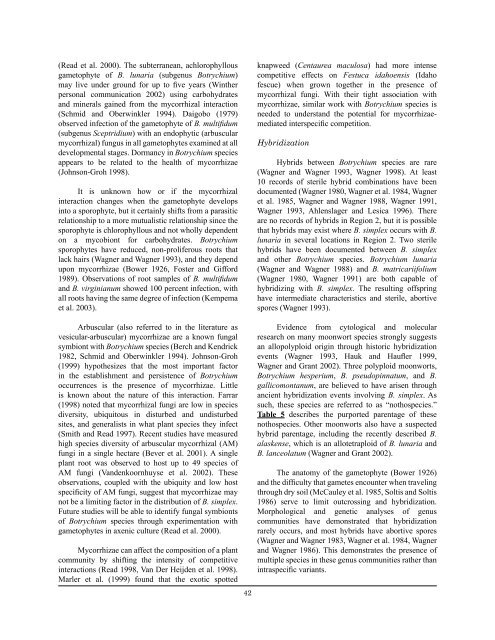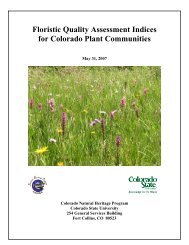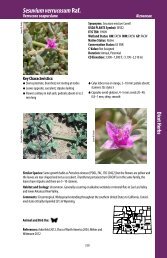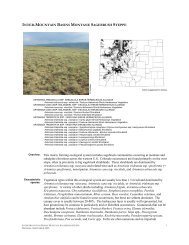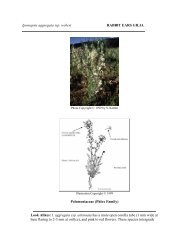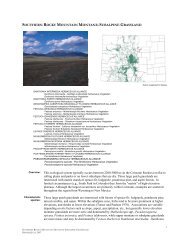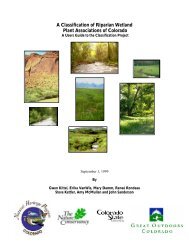Botrychium simplex E. Hitchcock (little grapefern) - Colorado Natural ...
Botrychium simplex E. Hitchcock (little grapefern) - Colorado Natural ...
Botrychium simplex E. Hitchcock (little grapefern) - Colorado Natural ...
Create successful ePaper yourself
Turn your PDF publications into a flip-book with our unique Google optimized e-Paper software.
(Read et al. 2000). The subterranean, achlorophyllous<br />
gametophyte of B. lunaria (subgenus <strong>Botrychium</strong>)<br />
may live under ground for up to five years (Winther<br />
personal communication 2002) using carbohydrates<br />
and minerals gained from the mycorrhizal interaction<br />
(Schmid and Oberwinkler 1994). Daigobo (1979)<br />
observed infection of the gametophyte of B. multifidum<br />
(subgenus Sceptridium) with an endophytic (arbuscular<br />
mycorrhizal) fungus in all gametophytes examined at all<br />
developmental stages. Dormancy in <strong>Botrychium</strong> species<br />
appears to be related to the health of mycorrhizae<br />
(Johnson-Groh 1998).<br />
It is unknown how or if the mycorrhizal<br />
interaction changes when the gametophyte develops<br />
into a sporophyte, but it certainly shifts from a parasitic<br />
relationship to a more mutualistic relationship since the<br />
sporophyte is chlorophyllous and not wholly dependent<br />
on a mycobiont for carbohydrates. <strong>Botrychium</strong><br />
sporophytes have reduced, non-proliferous roots that<br />
lack hairs (Wagner and Wagner 1993), and they depend<br />
upon mycorrhizae (Bower 1926, Foster and Gifford<br />
1989). Observations of root samples of B. multifidum<br />
and B. virginianum showed 100 percent infection, with<br />
all roots having the same degree of infection (Kempema<br />
et al. 2003).<br />
Arbuscular (also referred to in the literature as<br />
vesicular-arbuscular) mycorrhizae are a known fungal<br />
symbiont with <strong>Botrychium</strong> species (Berch and Kendrick<br />
1982, Schmid and Oberwinkler 1994). Johnson-Groh<br />
(1999) hypothesizes that the most important factor<br />
in the establishment and persistence of <strong>Botrychium</strong><br />
occurrences is the presence of mycorrhizae. Little<br />
is known about the nature of this interaction. Farrar<br />
(1998) noted that mycorrhizal fungi are low in species<br />
diversity, ubiquitous in disturbed and undisturbed<br />
sites, and generalists in what plant species they infect<br />
(Smith and Read 1997). Recent studies have measured<br />
high species diversity of arbuscular mycorrhizal (AM)<br />
fungi in a single hectare (Bever et al. 2001). A single<br />
plant root was observed to host up to 49 species of<br />
AM fungi (Vandenkoornhuyse et al. 2002). These<br />
observations, coupled with the ubiquity and low host<br />
specificity of AM fungi, suggest that mycorrhizae may<br />
not be a limiting factor in the distribution of B. <strong>simplex</strong>.<br />
Future studies will be able to identify fungal symbionts<br />
of <strong>Botrychium</strong> species through experimentation with<br />
gametophytes in axenic culture (Read et al. 2000).<br />
Mycorrhizae can affect the composition of a plant<br />
community by shifting the intensity of competitive<br />
interactions (Read 1998, Van Der Heijden et al. 1998).<br />
Marler et al. (1999) found that the exotic spotted<br />
42<br />
knapweed (Centaurea maculosa) had more intense<br />
competitive effects on Festuca idahoensis (Idaho<br />
fescue) when grown together in the presence of<br />
mycorrhizal fungi. With their tight association with<br />
mycorrhizae, similar work with <strong>Botrychium</strong> species is<br />
needed to understand the potential for mycorrhizaemediated<br />
interspecific competition.<br />
Hybridization<br />
Hybrids between <strong>Botrychium</strong> species are rare<br />
(Wagner and Wagner 1993, Wagner 1998). At least<br />
10 records of sterile hybrid combinations have been<br />
documented (Wagner 1980, Wagner et al. 1984, Wagner<br />
et al. 1985, Wagner and Wagner 1988, Wagner 1991,<br />
Wagner 1993, Ahlenslager and Lesica 1996). There<br />
are no records of hybrids in Region 2, but it is possible<br />
that hybrids may exist where B. <strong>simplex</strong> occurs with B.<br />
lunaria in several locations in Region 2. Two sterile<br />
hybrids have been documented between B. <strong>simplex</strong><br />
and other <strong>Botrychium</strong> species. <strong>Botrychium</strong> lunaria<br />
(Wagner and Wagner 1988) and B. matricariifolium<br />
(Wagner 1980, Wagner 1991) are both capable of<br />
hybridizing with B. <strong>simplex</strong>. The resulting offspring<br />
have intermediate characteristics and sterile, abortive<br />
spores (Wagner 1993).<br />
Evidence from cytological and molecular<br />
research on many moonwort species strongly suggests<br />
an allopolyploid origin through historic hybridization<br />
events (Wagner 1993, Hauk and Haufler 1999,<br />
Wagner and Grant 2002). Three polyploid moonworts,<br />
<strong>Botrychium</strong> hesperium, B. pseudopinnatum, and B.<br />
gallicomontanum, are believed to have arisen through<br />
ancient hybridization events involving B. <strong>simplex</strong>. As<br />
such, these species are referred to as “nothospecies.”<br />
Table 5 describes the purported parentage of these<br />
nothospecies. Other moonworts also have a suspected<br />
hybrid parentage, including the recently described B.<br />
alaskense, which is an allotetraploid of B. lunaria and<br />
B. lanceolatum (Wagner and Grant 2002).<br />
The anatomy of the gametophyte (Bower 1926)<br />
and the difficulty that gametes encounter when traveling<br />
through dry soil (McCauley et al. 1985, Soltis and Soltis<br />
1986) serve to limit outcrossing and hybridization.<br />
Morphological and genetic analyses of genus<br />
communities have demonstrated that hybridization<br />
rarely occurs, and most hybrids have abortive spores<br />
(Wagner and Wagner 1983, Wagner et al. 1984, Wagner<br />
and Wagner 1986). This demonstrates the presence of<br />
multiple species in these genus communities rather than<br />
intraspecific variants.


